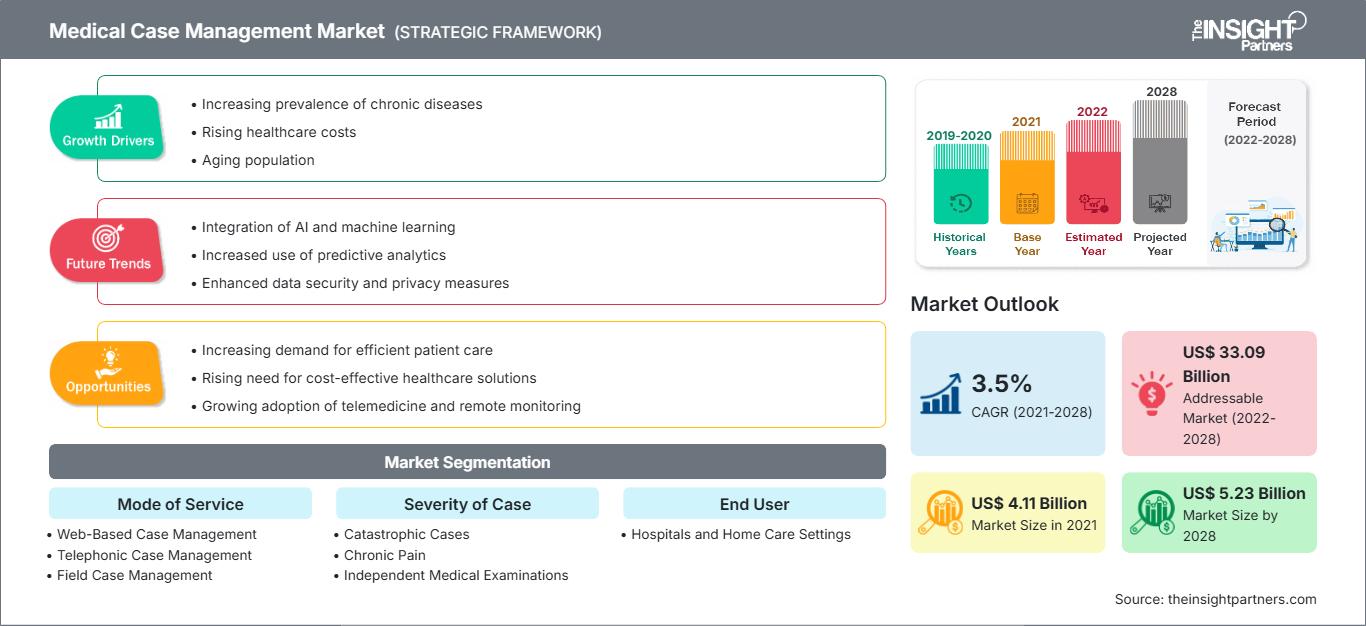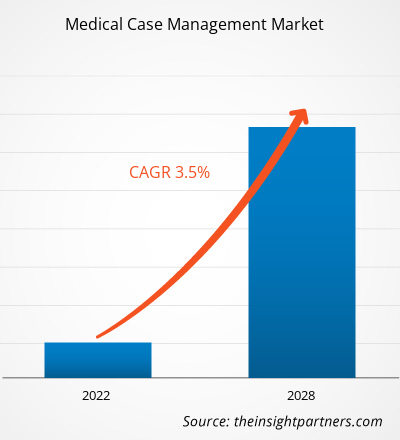Si prevede che il mercato della gestione dei casi medici raggiungerà i 5.228,35 milioni di dollari nel 2028, rispetto ai 4.109,20 milioni di dollari del 2021; si stima una crescita a un CAGR del 3,5% tra il 2021 e il 2028.
La gestione dei casi medici è un processo combinato di valutazione, raccomandazione, pianificazione, coordinamento e implementazione di vari servizi medici attraverso case manager o rappresentanti dei pazienti, per promuovere e garantire risultati di qualità e convenienti, insieme al miglior trattamento e alla migliore riabilitazione possibili. I servizi di gestione dei casi medici vengono erogati tramite modalità web, telefonica e di persona, sia presso gli ospedali che in strutture di assistenza domiciliare. I casi coperti da questi servizi possono variare da casi catastrofici a disabilità a breve termine e visite mediche indipendenti. Le aziende coinvolte nel settore generalmente stabiliscono collaborazioni e partnership con ospedali, cliniche specialistiche e altre strutture sanitarie, da un lato, e con datori di lavoro, organizzazioni, eventi e privati, dall'altro, per creare una catena di servizi da fornire a questi ultimi.
Il mercato della gestione dei casi medici viene analizzato in base alla modalità di servizio, alla gravità del caso, all'utente finale e all'area geografica. Il mercato, per area geografica, è ampiamente segmentato in Nord America, Europa, Asia-Pacifico, Medio Oriente e Africa e Sud e Centro America. Il rapporto di mercato sulla gestione dei casi medici offre approfondimenti e analisi approfondite del mercato, evidenziando parametri quali le dimensioni del mercato della gestione dei casi medici, le tendenze del mercato e le dinamiche di mercato; i progressi tecnologici nel mercato; e l'analisi del panorama competitivo dei principali attori del mercato della gestione dei casi medici.
Personalizza questo rapporto in base alle tue esigenze
Potrai personalizzare gratuitamente qualsiasi rapporto, comprese parti di questo rapporto, o analisi a livello di paese, pacchetto dati Excel, oltre a usufruire di grandi offerte e sconti per start-up e università
Mercato della gestione dei casi medici: Approfondimenti strategici

-
Ottieni le principali tendenze chiave del mercato di questo rapporto.Questo campione GRATUITO includerà l'analisi dei dati, che vanno dalle tendenze di mercato alle stime e alle previsioni.
La crescita del mercato della gestione dei casi medici è attribuita alla crescente prevalenza di malattie croniche e alla crescente adozione di progressi tecnologici che si prevede avranno un impatto significativo a breve, medio e lungo termine sul mercato della gestione dei casi medici nei prossimi anni. Tuttavia, una collaborazione inefficace e problemi di sicurezza e privacy ostacolano la crescita del mercato della gestione dei casi medici. Il rapporto di mercato della gestione dei casi medici identifica anche opportunità e tendenze future del mercato della gestione dei casi medici che possono avere possibili impatti sulla crescita del mercato.
Approfondimenti di mercato
La crescente prevalenza di malattie croniche alimenta la crescita del mercato della gestione dei casiSi registra un aumento del numero di casi di dolore cronico, disabilità a lungo e breve termine e casi catastrofici. Per trattare questi casi e aumentare il tasso di guarigione dei pazienti, è diventato essenziale mantenere un'adeguata gestione del paziente e delle cure. Il dolore cronico è associato a numerose condizioni fisiche e mentali e contribuisce a elevati costi sanitari e alla perdita di produttività. Diversi studi stimano che la prevalenza del dolore cronico vari dall'11% al 40%. Il dolore cronico provoca una mobilità limitata e ostacola le attività quotidiane; innesca dipendenza da oppioidi, ansia e depressione; scarsa salute percepita o ridotta qualità della vita. Secondo i Centers for Disease Control and Prevention (CDC), nel 2019, la prevalenza del dolore cronico era del 20,4% e la prevalenza del dolore cronico ad alto impatto era del 7,4%. I casi di dolore cronico sono più alti tra le donne (21,7%), gli adulti bianchi non ispanici (23,6%) e le persone di età pari o superiore a 65 anni (30,8%). Il dolore cronico ad alto impatto era più alto tra le donne (8,5%) e le persone di età pari o superiore a 65 anni (11,8%). Questo tipo di dolore è una delle condizioni più comuni per le quali gli adulti cercano assistenza medica. Pertanto, l'aumento dei casi di dolore cronico aumenta la domanda di servizi di gestione dei casi medici.
Le malattie croniche, come le malattie cardiache, il diabete, l'ictus e l'obesità, sono tra le principali cause di morte in tutto il mondo e rappresentano la quota maggiore dei costi sanitari della maggior parte dei Paesi. Secondo il CDC, 37,3 milioni di persone sono affette da diabete, che rappresenta la principale causa di amputazione degli arti inferiori e di insufficienza renale negli Stati Uniti. Il rapporto stima inoltre che ogni anno negli Stati Uniti vengano diagnosticati oltre 2 milioni di casi di diabete. Uno scenario simile, con un'elevata prevalenza del diabete, si osserva in altre regioni, come Europa, Asia-Pacifico e Medio Oriente e Africa. Secondo l'IDF Diabetes Atlas dell'International Diabetes Federation, pubblicato nel 2021, nel Sud-est asiatico 1 adulto su 11 (90 milioni) soffre di diabete. Inoltre, secondo l'American College of Cardiology Foundation, nel 2018 la coronaropatia (CHD) (43,8%) è stata la principale causa di morte per malattie cardiovascolari (CVD) negli Stati Uniti, seguita da ictus (16,8%), ipertensione (9,4%), insufficienza cardiaca (IC) (9,0%) e altre malattie cardiovascolari (17,9%). Entro il 2035, si prevede che oltre 130 milioni di adulti nella popolazione statunitense (45,1%) soffriranno di qualche forma di CVD e che i costi totali delle CVD raggiungeranno 1,1 trilioni di dollari nel 2035. Pertanto, l'aumento della popolazione geriatrica e le patologie croniche correlate creano la necessità di servizi di gestione dei casi medici per supporto, trattamento e riabilitazione.
Inoltre, il tasso di obesità sta crescendo rapidamente tra le popolazioni dei paesi sviluppati e in via di sviluppo in tutto il mondo. Stili di vita non sani e sedentari sono tra i principali fattori che aumentano il numero di casi di obesità. Secondo l'Organizzazione per la Cooperazione Economica (OCSE), nel 2020, oltre 1,9 miliardi di adulti erano in sovrappeso. La popolazione in sovrappeso è cresciuta rapidamente in Canada, Australia, Cile, Regno Unito e Sudafrica. Si prevede che la popolazione obesa sarà elevata negli Stati Uniti, in Messico e in Inghilterra, raggiungendo rispettivamente circa il 47%, il 39% e il 35% entro i prossimi due decenni. Secondo i dati raccolti dal National Safety Council (NSC), nel 2019 negli Stati Uniti sono stati segnalati 48,3 milioni di infortuni. Il costo stimato per il trattamento di questi infortuni è stato di 1.097,9 miliardi di dollari. Inoltre, nel 2019 si sono verificati 173.040 decessi prevenibili correlati a infortuni. I decessi prevenibili possono essere attribuiti principalmente a un aumento del 5% sia dei decessi per avvelenamento (incluse le overdose da oppioidi) che dei decessi per caduta. Pertanto, la crescente incidenza di lesioni catastrofiche e la crescente prevalenza dell'obesità in tutto il mondo stanno guidando la domanda di servizi di gestione dei casi medici.
Modalità di analisi basata sul servizio
Il mercato globale della gestione dei casi medici, in base alla modalità di servizio, è segmentato in gestione dei casi basata sul web, gestione dei casi telefonica, gestione dei casi sul campo e gestione dei casi bilingue. Il segmento della gestione dei casi telefonica ha detenuto la quota maggiore del mercato nel 2021 e si prevede inoltre che registrerà il CAGR più elevato durante il periodo di previsione.
Gravità delle analisi basate sul caso
In base alla gravità del caso, il mercato della gestione dei casi medici è segmentato in casi catastrofici, dolore cronico, visite mediche indipendenti, invalidità a lungo termine e invalidità a breve termine. Il segmento della disabilità a lungo termine ha detenuto la quota maggiore di mercato nel 2021 e si prevede che manterrà una quota significativa durante il periodo di previsione. Tuttavia, si prevede che il segmento del dolore cronico registrerà il CAGR più elevato dal 2021 al 2028.
Informazioni basate sull'utente finale
In base all'utente finale, il mercato della gestione dei casi medici è suddiviso in ospedali e strutture di assistenza domiciliare. Il segmento ospedaliero ha detenuto una quota maggiore di mercato e si prevede che registrerà un CAGR più elevato durante il periodo di previsione.
Diverse aziende che operano nel mercato della gestione dei casi medici adottano strategie come lanci di prodotti, fusioni e acquisizioni, collaborazioni, innovazioni di prodotto ed espansioni del portafoglio prodotti per espandere la propria presenza a livello mondiale, mantenere un marchio e soddisfare la crescente domanda dei consumatori.
Mercato della gestione dei casi mediciLe tendenze regionali e i fattori che influenzano il mercato del Medical Case Management durante il periodo di previsione sono stati ampiamente spiegati dagli analisti di The Insight Partners. Questa sezione illustra anche i segmenti e la geografia del mercato del Medical Case Management in Nord America, Europa, Asia-Pacifico, Medio Oriente e Africa, America Meridionale e Centrale.
Ambito del rapporto di mercato sulla gestione dei casi medici
| Attributo del rapporto | Dettagli |
|---|---|
| Dimensioni del mercato in 2021 | US$ 4.11 Billion |
| Dimensioni del mercato per 2028 | US$ 5.23 Billion |
| CAGR globale (2021 - 2028) | 3.5% |
| Dati storici | 2019-2020 |
| Periodo di previsione | 2022-2028 |
| Segmenti coperti |
By Modalità di servizio
|
| Regioni e paesi coperti |
Nord America
|
| Leader di mercato e profili aziendali chiave |
|
Densità degli operatori del mercato della gestione dei casi medici: comprendere il suo impatto sulle dinamiche aziendali
Il mercato della gestione dei casi medici è in rapida crescita, trainato dalla crescente domanda degli utenti finali, dovuta a fattori quali l'evoluzione delle preferenze dei consumatori, i progressi tecnologici e una maggiore consapevolezza dei vantaggi dei prodotti. Con l'aumento della domanda, le aziende stanno ampliando la propria offerta, innovando per soddisfare le esigenze dei consumatori e sfruttando le tendenze emergenti, alimentando ulteriormente la crescita del mercato.

- Ottieni il Mercato della gestione dei casi medici Panoramica dei principali attori chiave
Profili aziendali
- Gestione dei casi EagleOne
- EK Health Services Inc
- Genex Services, LLC
- MMRO INC
- TRIUNE Health Group
- PayerFusion Holdings LLC.
- GMMI, Inc.
- Amministratori della Sierra Nevada
- AXIOM MEDICAL CONSULTING, LLC
- Gruppo di gestione dei casi medici
- Analisi storica (2 anni), anno base, previsione (7 anni) con CAGR
- Analisi PEST e SWOT
- Valore/volume delle dimensioni del mercato - Globale, Regionale, Nazionale
- Industria e panorama competitivo
- Set di dati Excel
Report recenti
Rapporti correlati
Testimonianze
Motivo dell'acquisto
- Processo decisionale informato
- Comprensione delle dinamiche di mercato
- Analisi competitiva
- Analisi dei clienti
- Previsioni di mercato
- Mitigazione del rischio
- Pianificazione strategica
- Giustificazione degli investimenti
- Identificazione dei mercati emergenti
- Miglioramento delle strategie di marketing
- Aumento dell'efficienza operativa
- Allineamento alle tendenze normative






















 Ottieni un campione gratuito per - Mercato della gestione dei casi medici
Ottieni un campione gratuito per - Mercato della gestione dei casi medici